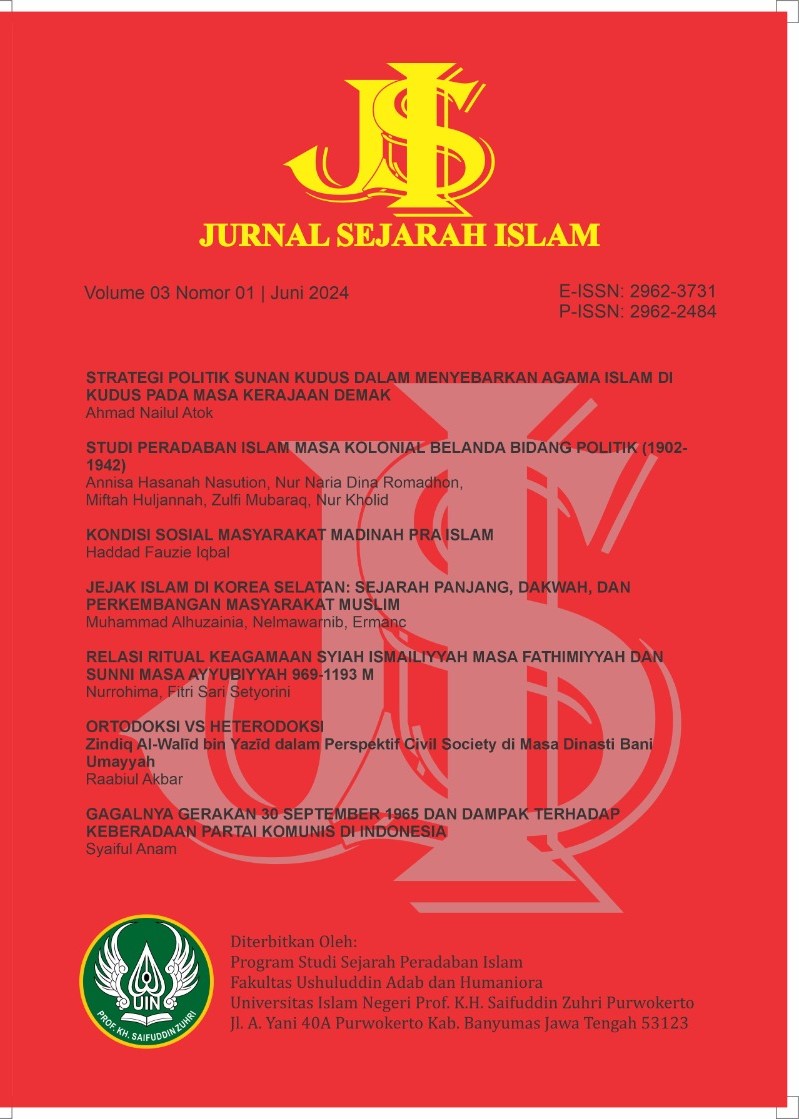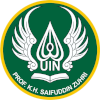Ortodoksi Vs Heterodoksi: Zindiq Al-Walīd bin Yazīd dan Abd al-Ṣamad bin ‘Abd al-A’lā dalam Perspektif Civil Society di Masa Dinasti Bani Umayyah
DOI:
https://doi.org/10.24090/jsij.v3i1.9341Kata Kunci:
Ortodoksi, Heterodoksi, Zindiq, Bani Umayyah, AbbasiyahAbstrak
Khalifah memperlakukan zindiq dengan cara yang berbeda pada dua masa yang berbeda. Pada masa Dinasti Bani Umayah, zindiq lebih sedikit dan tidak menarik perhatian besar dari khalifah selama mereka tidak mengganggu kekuasaannya. Tulisan ini bertujuan membuktikan bahwa kasus zindiq sebenarnya bukan masalah agama, melainkan kontestasi politik dengan latar agama yang kuat. Penelitian ini menggunakan pendekatan kualitatif dengan menggunakan kitab Tārkīh al-Ṭabarī Tārīkh al-Rusul wa al-Mulūk karya Ibn Jarīr al- Ṭabarī sebagai data primer. Pendekatan kualitatif dipilih untuk memahami konteks historis terkait dengan konsep ortodoksi dan heterodoksi. Penulis membatasi penelitian pada Dinasti Bani Umayah. Berdasarkan literatur klasik dan konsep ortodoksi dan heterodoksi, tulisan ini membuktikan adanya pergeseran konteks politik dalam kasus zindiq.Referensi
Amīn, Ahmad. (2012 ) “Ḍuḥā Al-Islām.” In Ḍuḥā Al-Islām. Hindāwī.
Arkoun, Mohammed. (1994) Nalar Islami Dan Nalar Modern: Berbagai Tantangan Dan Jalan Baru. Jakarta: INIS.
Darmawan, D. (2012) “Ortodoksi Dan Heterodoksi Tafsir.” Refleksi: Jurnal Kajian
Agama Dan Filsafat. core.ac.uk,. https://core.ac.uk/download/pdf/292069392.pdf.
El Fegiery, Moataz, Ekie Abouaoun, Harith Hasan Al-Qarawee, Mohammad Fadel, Omar Iharchane, Driss Maghraoui, Imad Salamey, and Asma T. Uddin.(2017). “Taking Beliefs to Court Blasphemy, Heresy, and Freedom of Expression under Islamic Law.” Atlantic Council, Islam and Human Rights. http://www.jstor.com/stable/resrep03717.5.
Galtung, J., D. Fischer, J. Galtung, and D. Fischer. (2013) “Conflict Transformation by Peaceful Means (the Transcend Method).” Johan Galtung: Pioneer of … https://doi.org/10.1007/978-3-642-32481-9_5.
al-Gazali. (1952) Al-Munqiẓ Min al-Ḍalāl. Mesir: Maktabah wa Maṭba’ah Muhammad Ālī Sābikh wa Awlāduhu. Ibrahim, Mahmood. (Spring 1994) “Religious Inquisition As Social Policy: The Persecution Of The ‘Zanadiqa’ In The Early Abbasid Caliphate.” PlutoJournals Vol. 16. https://www.jstor.org/stable/41858089.
Isabel Fierro Bello, Maria. (1988 1987) “Accusations Of ‘Zandaqa’ In Al-Andalus.” Istituto per l’Oriente C. A. Nallino Vol. 5/6. https://www.jstor.org/stable/25802607.
Jabir Alalwani, Taha. (2011) Apostasy in Islam. International Institute of Islamic Thought,. https://www.jstor.org/stable/j.ctvk8w22r.10.
Jābir al-Jazāirī, Abu Bakar. (1984)Minhāj Al-Muslim. Kairo: Dār al-Turāṡ.
Langer, Robert, and Udo Simon. (2008) “The Dynamics of Orthodoxy and Heterodoxy. Dealing with Divergence in Muslim Discourses and Islamic Studies.” Brill Vol. 48. https://www.jstor.org/stable/27798270.
MacEoin, Denis. (June 1990) “Orthodoxy and Heterodoxy in Nineteenth-Century Shiʿism: The Cases of Shaykhism and Babism.” American Oriental Society Vol. 110. https://www.jstor.org/stable/604537.
Mc. Donough, Sheilla. (1993) Orthodoxy and Heterodhoxy. Vol. 2. New York: Simon
& Schuster Macmillah. Mill, J. S., and P. B. Press. (2009) “On LiBertY at 150.” POLICY. cis.org.au,.https://www.cis.org.au/wp-content/uploads/2015/04/images/stories/policymagazine/25-2-09-andrew-norton-2.pdf.
Mill, J. S. (2001). On LiBerty. Batoche Books Limited.
Milton, J, Wehr, Hans. (1960) A Dictionary of Modern Written Arabic-English. London: Macdonald & Evans.
Reese, Willian L. (1996) Dictionary of Philosopy and Religion, Eastern and Western Thought. New York: Humanity Books.
Ridwan, H. Kafrawi. (1999) Ensiklopedi Islam. Jakarta: PT Ichtiar Van Hoeve.
Schrode, Paula. (2008) “The Dynamics of Orthodoxy and Heterodoxy in Uyghur Religious Practice.” Brill Vol. 48. https://www.jstor.org/stable/27798274.
Ṭabarī, Abū Ja’far Muhammad bin Jarīr al-. (1970) Tārīkh Al-Umam Wa al-Mulūk. Vol. 4. Kairo.
Taylor, John. (April 1967) “An Approach to the Emergence of Heterodoxy in Mediaeval Islām.” Cambridge University Press Vol. 2. https://www.jstor.org/stable/20004654.
Weber, M. (2009)“The Theory of Social and Economic Organization.” books.google.com. https://books.google.com/books?hl=en&lr=&id=G3TYBu6-
G0C&oi=fnd&pg=PT2&dq=%22max+weber%22+conflict+theory&ots=Xs
QmPHpGE2&sig=YF79lUVht0pS3vmn-HpQ6JQqZwc.
William G. T. Shedd, D.D. (1893). Orthodoxy And Heterodoxy. Charles Scribner’s Sons.
Żahabī, Syamsuddīn Muhammad bin Ahmad bin ’Uṡmān. (2006) al-. Siyar A’lām alNubalā’. Vol. 6. Kairo: Dār al-Hadīṡ.
Unduhan
Diterbitkan
Cara Mengutip
Terbitan
Bagian
Lisensi
Hak Cipta (c) 2024 Raabiul Akbar

Artikel ini berlisensi Creative Commons Attribution 4.0 International License.









